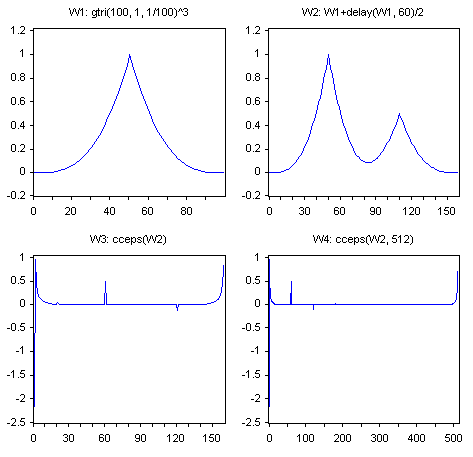
DADiSP Online Help
Click here to see this page in full context

Calculates the complex cepstrum.
CCEPS(series, n)
(c, d) = CCEPS(series)
|
series |
- |
An input series or array. |
|
n |
- |
Optional. An integer, the number of samples to use. If |
A real series or array.
(c, d) = CCEPS(s) returns the cepstrum in c and the lag used to unwrap the phase in d.
W1: gtri(100, 1, 1/100)^3
W2: W1+delay(W1, 60)/2
W3: cceps(W2)
W4: cceps(W2, 512)

W2 adds a synthesized echo at 60 seconds to the data of W1.
W3 displays a small peak at t == 60 indicating the presence of the echo. W4 performs the same calculation with the data padded to 512 samples.
W1: {1, -4.0996, 8.4057, -10.1765, 7.7801, -3.5142, 0.7939}
W2: cceps(W1, 1024)
returns the example listed in [2].
The complex cepstrum of a series is essentially ifft(log(fft(s))). However, the complex log calculation requires the evaluation of the continuous phase component. CCEPS unwraps the phase using Shafer's Algorithm. A line is subtracted from the unwrapped phase to remove the integer lag component.
(c, d) = cceps(s)
returns both the cepstrum and the lag used to unwrap the phase such that:
icceps(c, d)
ideally returns s if mean(s) > 0.
CCEPS was tested successfully against the output from [2].
[1] Oppenheim & Shafer
Discrete-Time Signal Processing
Prentice Hall, 1989
pp 788-792
[2] IEEE Press
Programs for Digital Signal Processing
IEEE Press, 1979
Section 7